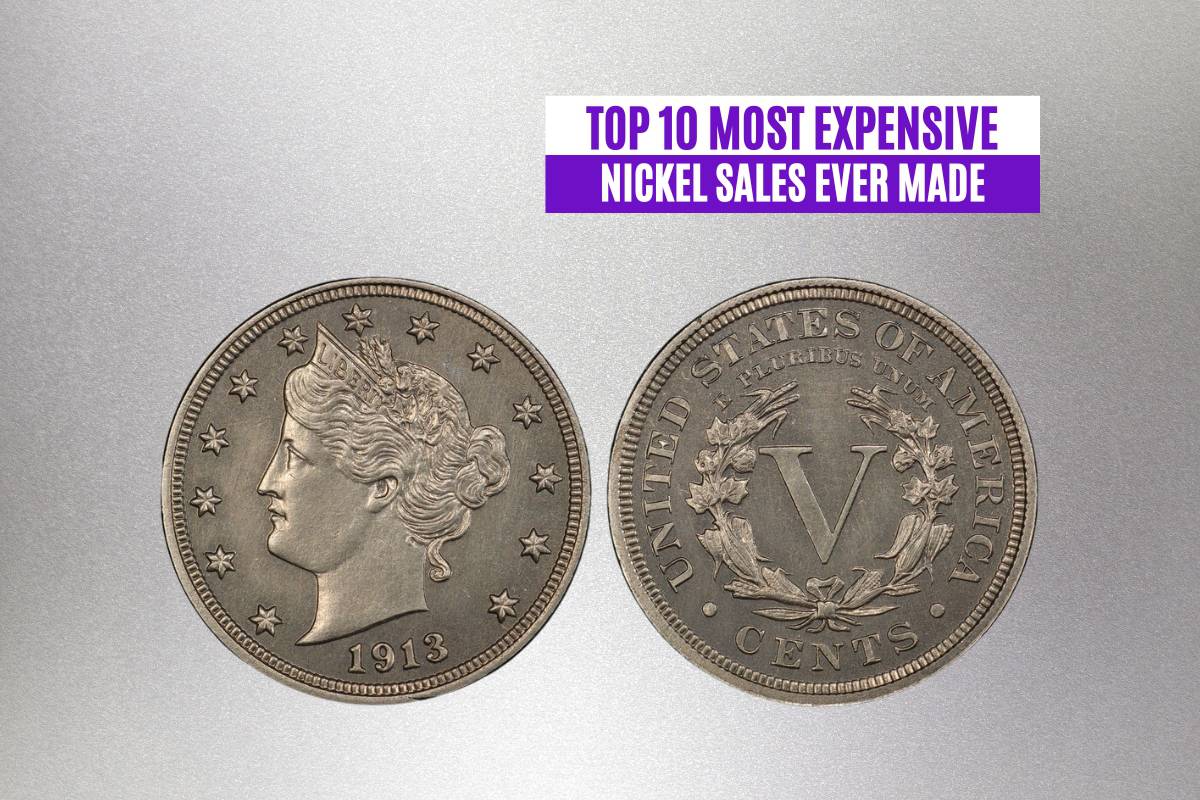Even though the United States was founded in 1776, it didn’t have an official currency until 1792, when the Coinage Act was passed. This early currency consisted entirely of coins, many of which are worth a fortune today. Even coins with low denominations, like nickels ($0.05), can sell for thousands or millions of dollars!
The most expensive nickel ever sold is the Eliasberg 1913 Liberty Head Nickel. This five-cent piece sold for $5 million in 2007, and it’s one of the hundreds of U.S. coins collected by numismatist Louis E. Eliasberg between 1925 and 1950.
If you have a jar of old coins, you might want to pour out these pieces and sort through them. You never know; you might find a high-value nickel! Explore this ranking to see which five-cent pieces have sold for the biggest bucks.
Here Are the Top 10 Most Expensive Nickels Ever Sold:
- Eliasberg 1913 Liberty Head Nickel – $5 million
- 1918/7-D Buffalo Nickel – $350,750
- 1926-S Buffalo Nickel – $322,000
- 1916 Buffalo Nickel (Doubled Die Obverse) – $281,750
- 1880 Shield Nickel – $198,995
- 1913-D Buffalo Nickel – $143,750
- 1920-D Buffalo Nickel – $138,000
- 1867 Cameo Shield Nickel (Proof with Rays) – $132,250
- 1927-S Buffalo Nickel – $125,350
- 1918-S Buffalo Nickel – $125,350
10. 1918-S Buffalo Nickel – $125,350
Grade: NGC MS-66
Auction House: Bowers & Merena
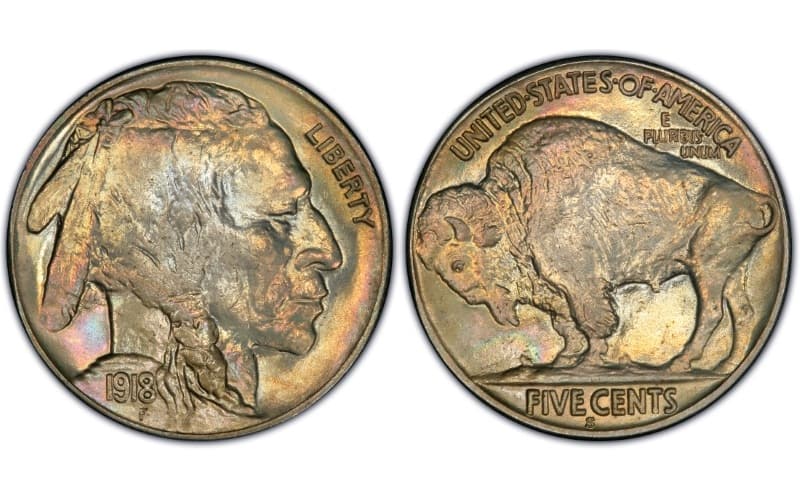
The U.S. Mint produced Buffalo nickels between 1913 and 1938. These coins are so-called because of the buffalo image on their reverse (back) sides.
And while these nickels don’t contain silver (like those struck between 1942 and 1945), they’re generally some of the most valuable nickels due to their age and collectability. The 1918-S Buffalo nickel that sold in 2008 for $125,350 is a prime example.
This nickel (which is mostly made of copper) might be more than 100 years old, but it’s in top-notch condition. It has a grade of MS-66, meaning it’s in mint shape and features few scratches or signs of damage.
Struck at the San Francisco Mint, which now only produced proof coins, this nickel is a lustrous piece of U.S. history that’s worth far more than its original five-cent designation.
However, it’s not the most valuable Buffalo nickel!
9. 1927-S Buffalo Nickel – $125,350
Grade: NGC MS-66
Auction House: Bowers & Merena
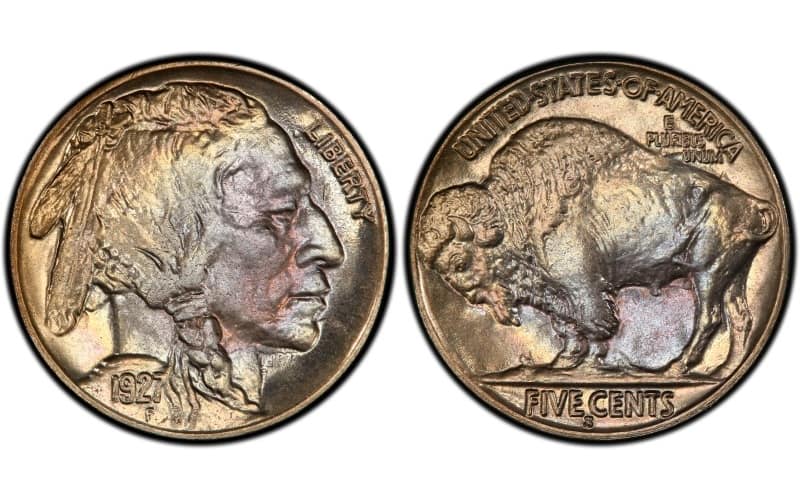
The 1918-S Buffalo nickel has a brownish tint from its high copper percentage. But the 1927-S Buffalo nickel looks far more familiar to the nickels minted today, with a silvery finish that gleams brilliantly.
This difference in appearance might stem from changes in the striking process between 1918 and 1927. However, the age difference could also play a role, with “newer” nickels retaining their silver-colored nickel finish a little better.
Still, it’s worth noting that all Buffalo nickel coins are 75% copper (and only 25% nickel, despite the coin’s name).
Sold for the same price ($125,350) as the 1918-S Buffalo nickel described above, the 1927-S Buffalo nickel is also a product of the San Francisco Mint. Sadly, this mint location stopped striking circulation coins in 1975.
As such, all circulation coins bearing the “S” mint mark are historically-significant pieces of U.S. coinage. That said, nickels struck at the Denver Mint can be just as valuable (if not more so) than those struck in San Francisco.
8. 1867 Cameo Shield Nickel (Proof with Rays) – $132,250
Grade: NGC PR-66
Auction House: Heritage Auctions
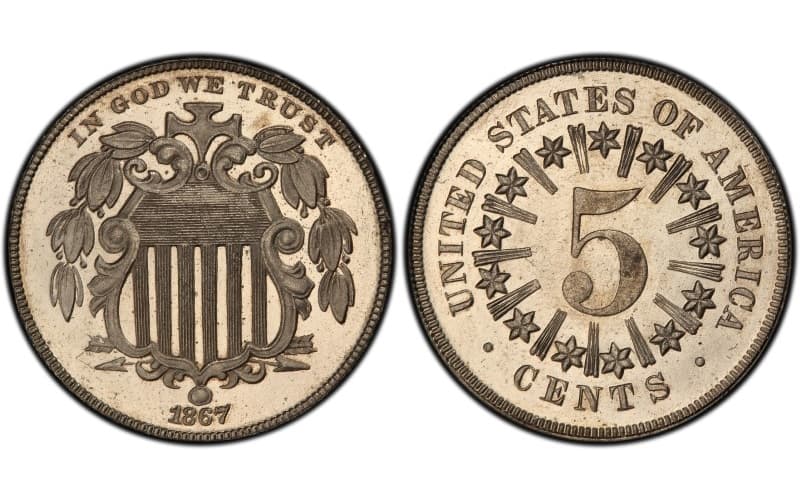
Cameo coins appear to have an almost two-tone finish, with darker “backgrounds” and lighter, “frosted” raised subjects. Reverse cameo coins, on the other hand, have darker foregrounds and subjects with lighter backdrops.
Most circulated coins don’t exhibit this difference in shading, but proof coins do.
This includes the 1867 Cameo Shield Nickel, an exceptionally rare proof coin. Only ten of these old U.S. nickels are around today.
These nickels look far more similar to European coinage than U.S. coins, with a large number “5” on the reverse side (surrounded by stars and rays). Compare this to pretty much all other nickels, which have “FIVE CENTS” on their reverse side instead.
Many coin collectors of the time hated the design of this coin, and its design was changed almost immediately after its 1866 release. As such, most Shield nickels lack the stars and rays seen on the reverse side. But not the unique proof version that sold in 2004.
Due to this coin’s scarcity, proof quality, and historical significance, it’s easily one of the most valuable nickels ever released by the U.S. Mint. When this 1867 nickel went to auction, it sold for a whopping $132,250.
7. 1920-D Buffalo Nickel – $138,000
Grade: NGC MS-67
Auction House: Bowers & Merena
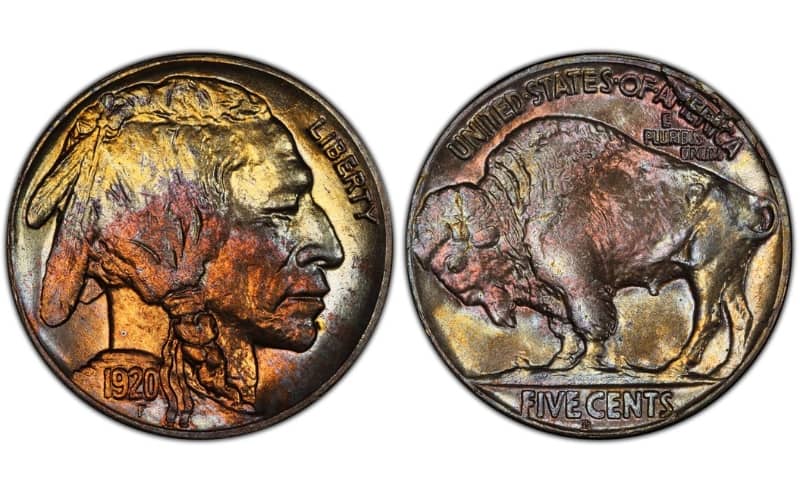
Any given still-operating U.S. Mint location strikes millions (if not billions) of coins each year. But during some years, a few locations produce a far lower number of coins.
For example, in 1920, the Denver Mint struck just under 10 million Buffalo nickels. This might seem like a lot, but it’s crucial to note that the U.S. population in 1920 was over 106 million. So even when these nickels first hit the streets, there wasn’t enough for everyone!
Nowadays, these nickels are increasingly rare to come by, especially those in mint condition. So, when an MS-67 1920-D Buffalo nickel went up for auction in 2008, coin collectors got excited.
This nickel sold for $138,000 and remains one of the most sought-after nickels of all time.
For perspective, this antique five-cent piece is more valuable than several of the world’s most expensive birthstones. Imagine being able to trade a nickel for a flawless-quality aquamarine, garnet, or opal gem!
6. 1913-D Buffalo Nickel – $143,750
Grade: NGC MS-68
Auction House: Bowers & Merena
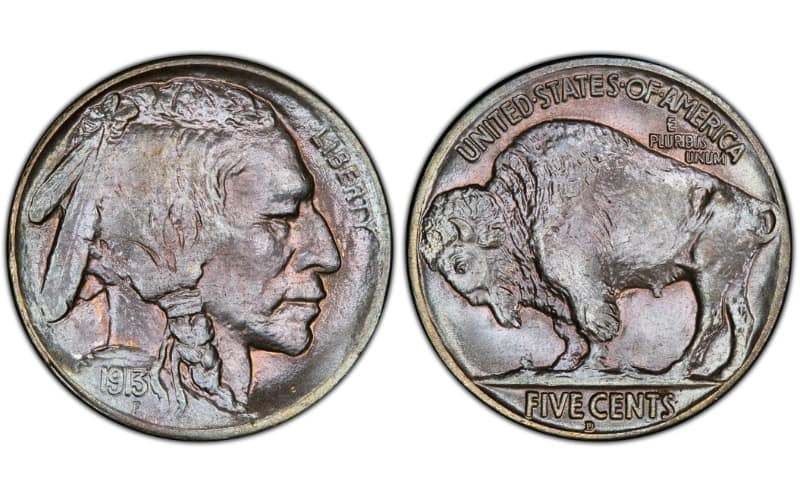
Speaking of the Denver Mint and its occasionally low nickel yields, we can’t forget to talk about the 1913-D Buffalo nickel. This coin, part of the first wave of Buffalo nickels (which replaced the Liberty Head nickel), is essentially a U.S. artifact.
Most of these coins are long gone, either sitting protected in private collections or degraded to the point of being unrecognizable. But a rare few look just as shiny and lustrous as the day they were minted.
Take the MS-68 1913-D Buffalo nickel, for example. This Mint State Buffalo nickel is still an eye-catching silver color and exhibits almost no signs of aging.
Even better (from a collector’s standpoint), the Denver Mint only struck about 5 million of these coins. Comparatively speaking, that’s a low yield.
Consequently, this nickel sold for $143,750 when it went to auction in 2008.
5. 1880 Shield Nickel – $198,995
Grade: PCGS MS-66
Auction House: eBay
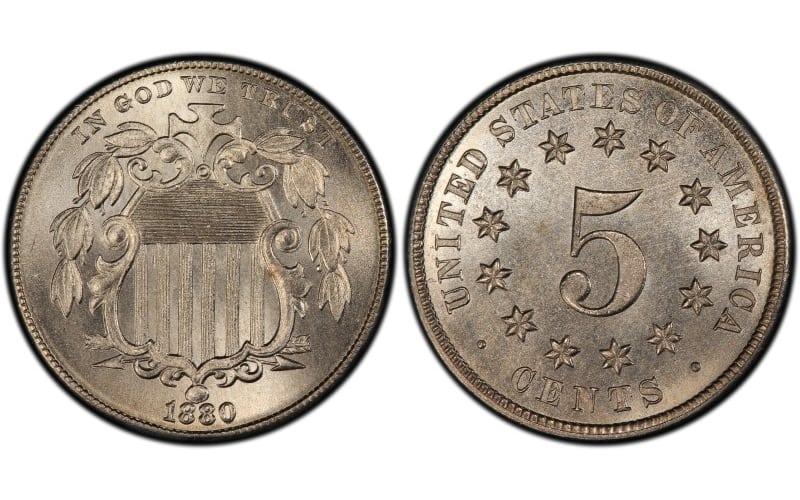
The iconic (and, some would say, ugly) Shield nickel was discontinued in 1883, being replaced by the Liberty Head nickel.
This coin might not have won any design competitions, but it’s notable for being the first five-cent piece ever produced by the U.S. Mint. As a result, the few rare Shield nickels left today are particularly valuable, especially when they’re found in like-new condition.
The 1880 Shield nickel that sold on eBay in January 2023 for $198,995 might be the finest 1880 Shield nickel on Earth. It’s almost flawless. The only signs of wear are on the reverse side, along the “CENTS” and stars markings.
So, even though this Mint State coin isn’t an MS-68 specimen (meaning it’s basically perfect), it’s still worth a small fortune thanks to its condition and rarity. It even has a slight cameo effect thanks to its shining surfaces, a feature that’s particularly noticeable on the obverse (front) side.
4. 1916 Buffalo Nickel (Doubled Die Obverse) – $281,750
Grade: PCGS MS-64
Auction House: Bowers & Merena
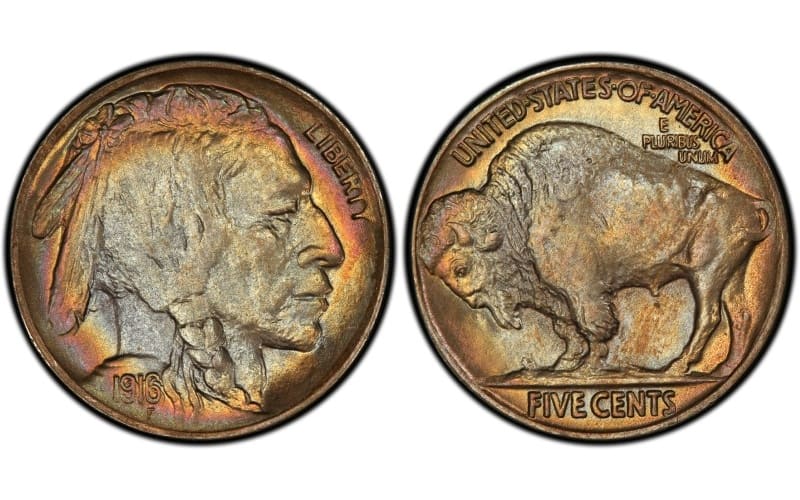
At first glance, you might mistake some Buffalo nickels for pennies. After all, these coins were primarily composed of copper, not nickel. Over time, the thin nickel coating on many Buffalo nickels wears away or oxidizes, revealing a brownish copper color beneath.
While this hue might not appeal to all collectors, especially those looking for nickels with a like-new appearance, it’s often a good indicator of a coin’s age. Most 1916 Buffalo nickels, now more than a century old, are definitely showing their age via their coloration.
But that doesn’t mean that these copper-colored nickels aren’t valuable. Just take a look at an MS-64 1916 Buffalo nickel that sold for $281,750 in 2004.
Even though this five-cent piece is brown, it’s still lustrous and clean. But its shiny exterior isn’t the primary reason it’s worth big bucks. No, instead, this coin is valuable because of its noticeable striking mistake.
If you look closely at this nickel’s date, you’ll notice that the year date appears to be pressed twice, with the bottom pressing almost running to the right of the uppermost pressing.
This flaw occurs when coins are pressed twice in quick succession or with two dies of the same year but with slightly re-positioned dates.
3. 1926-S Buffalo Nickel – $322,000
Grade: NGC MS-66
Auction House: Bowers & Merena
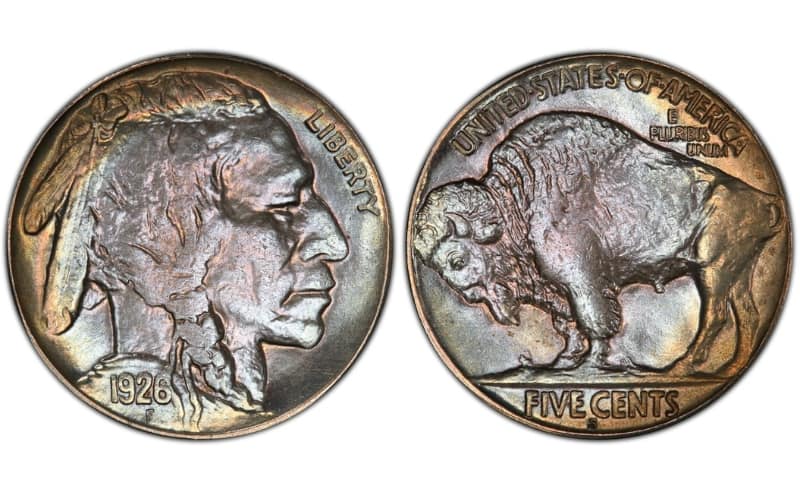
The most valuable regular-strike Buffalo nickel is, without a doubt, the 1926-S Buffalo nickel.
This coin, produced at the San Francisco Mint, was one of the lowest-yield nickels of the 20th century. Fewer than one million of these nickels were struck in San Francisco, making them a rarity right off the bat.
But the real key to this coin’s value is its condition. Nearly all of these coins entered circulation, ending up in the pockets, jars, and piggy banks of people all over the country. This level of use has left most 1926-S Buffalo nickels with obvious smoothing and signs of damage.
Few of these coins are ever found in Mint State condition. But in 2008, a rare exception was sold at auction for $322,000. This MS-66 coin might be the highest-quality 1926-S Buffalo nickel on the planet.
2. 1918/7-D Buffalo Nickel – $350,750
Grade: PCGS MS-65
Auction House: Bowers & Merena
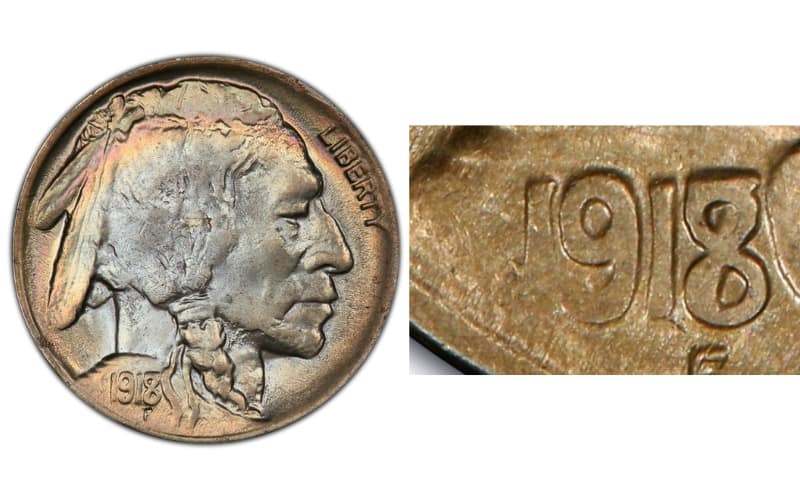
The 1918/7-D Buffalo nickel is the most valuable Buffalo nickel in the world. For the price of one of these nickels, you could afford one of the most expensive Super Bowl tickets!
While many coin collectors search for pristine regular-strike coins to add to their collection, others have a keen eye for coins that feature striking mistakes. The 1918/7-D Buffalo nickel is sure to appeal to the latter type of collector.
This nickel’s name stems from the fact that the die used to strike it was originally used to produce 1917 nickels. The die’s engraving was altered to change the date to 1918, but you can still see a “7” mixed in with the eight at the tail-end of the year. So this particular nickel has what’s called an overdate error. Hence the name “1918/7” nickel.
One of these unique coins, produced at the Denver Mint, sold for $350,750 in 2006. Although this coin’s grade isn’t as high as other Buffalo nickels, it’s still a Mint State (MS) specimen that’s bound to appreciate over time.
Still, if you think this Buffalo nickel’s auction price was noteworthy, wait until you find out what the Eliasberg 1913 Liberty Head nickel sold for.
1. Eliasberg 1913 Liberty Head Nickel – $5 million
Grade: PCGS PR-66 CAC
Auction House: N/A (Private sale)
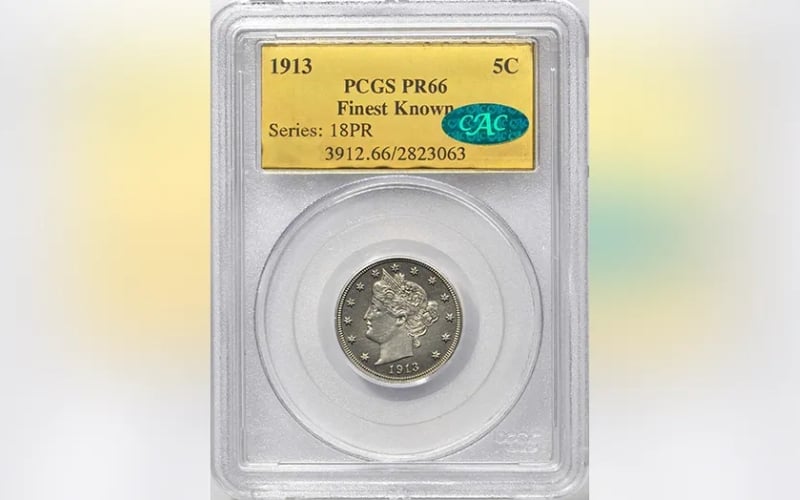
The most expensive nickel is the Eliasberg 1913 Liberty Head nickel. This nickel sold for $5 million in 2007, making it 10 million times more valuable than its original denomination of five cents.
Somewhat counterintuitively, this nickel has a higher value than the world’s most expensive quarter! But when you consider that it came from such an astounding private collection, it’s easier to understand its multi-million-dollar price tag.
You see, this Liberty Head nickel was part of the Eliasberg collection, a vast and complete collection of U.S. coins amassed by numismatist (coin collector) Louis E. Eliasberg.
Eliasberg began collecting U.S. coins in earnest in 1925, intending to possess every U.S. coin ever minted. This doesn’t mean that he wanted to own every coin ever released by the U.S. Mint, but that he wanted at least one of every specimen (including coins for specific years, mint marks, and denominations).
He achieved his goal in 1950, creating a collection that was the first and only of its kind. It’s also worth noting that Eliasberg focused his attention on acquiring only the highest-quality coins in the best condition.
Consequently, this definitive collection consisted of some of the finest specimens of U.S. currency ever released. The 1913 Liberty Head nickel that sold for millions in 2007 isn’t only a piece from this original collection but also in stellar shape, especially considering its age.
In fact, this nickel is in such great condition that it managed to earn a coveted Certified Acceptance Corporation (CAC) sticker! Only the best-quality coins earn a CAC sticker.
In short, this coin is the most pristine (and potentially the most historically significant) 1913 Liberty Head nickel in the world.
What’s the Most Expensive Nickel Ever Sold?
Although nickels have a denomination of $0.05, some are worth far more due to their age, rarity, or silver content. The most expensive nickel of all time is the Eliasberg 1913 Liberty Head nickel, which sold for $5 million in 2007.
This nickel was part of Louis E. Eliasberg’s incredible coin collection, which consisted of at least one specimen of every U.S. coin minted. This vast collection was one-of-a-kind and contained only the highest-quality coins. These coins sell for top-dollar prices despite their low denominations.
Learn more about the world’s most expensive items by checking out these related articles now!

